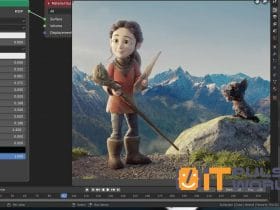Immersive experiences: The new reality of commerce
LATEST POSTS

Understanding AR, VR, and MR: The trident that opens the doors to a memorable customer experience, high-quality communication, and uninterrupted business growth.
Key points:
- The characteristics of the different immersive experiences
- How Immersive Experiences Are Transforming Business Today
- Why immersive experiences are the next big trend in commerce
An immersive experience virtually transports us from our surroundings. It takes us into a fully or partially illusory environment, creating the perception of being present in a space that does not physically exist.
Sometimes referred to as an interactive web experience, an immersive experience allows viewers to participate and interact with digitally visualized elements through content or tools that can include objects, environments, situations, and even other users.
The immersive experience, the new code for transforming businesses across different cultures and economies, is often multi-sensory. It aims to satisfy users’ innate curiosity through immersive moments that engage awareness from all angles.
Digitally constructed narratives are not required to conform to the real world’s physical limitations or cultural norms. This allows creators of immersive technologies to achieve what is usually considered unthinkable. And what does that entail? Bringing abstract concepts to life changes how we develop prototypes or approach investors.
Deciphering principles and processes for highly effective learning, teamwork, and R&D initiatives. Enabling virtual avatars to connect in artificially manufactured settings socially. Or, as is becoming increasingly popular, consumers can “try on” items to judge their suitability and fit for more intelligent purchasing decisions.
With digital transformation being the buzzword in boardrooms, organizations and businesses across all specialties and industries use immersive experiences and other related technologies in various innovative and impactful ways.
The big idea is to significantly improve the consumer journey or customer experience by empowering the participant with layers of information and surprising moments never seen before. Immersive technologies are finding increasingly important use cases in various domains such as education and training, healthcare, advertising, retail, art, decor, real estate, construction, engineering, gaming, research and development, automotive, events, hospitality, fitness, and entertainment. Yes, almost everyone wants in.
Immersive technologies are finding increasingly important use cases in a wide range of fields.
What does it take to design an impactful, immersive experience?
Criteria for designing and measuring an immersive experience…
Whether physical attributes, environments, or dramatis personae (plot characters), the key to a memorable immersive experience —as with all creative endeavors—is the authenticity of the recreation, detail, and storytelling. Since the physical world we are familiar with is three-dimensional, this process begins with converting an organization’s 2D assets, such as product photographs, manufacturing drawings, and catalog images, into 3D formats compatible with immersive reality frameworks.
Like any other form and format of content, how the viewer accesses or consumes an immersive experience is the next big digital transformation decision leaders must make. Will users need gadgets—headsets, controllers, trackers, and simulators—or can one jump right into the fray without an assortment of accessories and equipment?
Can one download an app to connect to the immersive universe, or can it be experienced on any internet-connected device? Does the participant have to follow a complex series of steps to enter “the zone,” or is it possible to enter effortlessly? There are no right or wrong answers, but as Enhance 3D & AR Solutions ’ gadget-free, app-free, plug-and-play innovation has shown, simple is still powerful.
Since the arrival of VR headsets, immersive experiences have been taken to the next level. Augmented reality headsets are set to revolutionize the sector. Click on “View in your space” to see this Oculus Rift VR Headset model in your home.
What are the different types of immersive experiences that exist?
A comparative look at AR and VR: today’s most advanced immersive technologies.
Relentless advances in R&D labs and technology studies make it easier for organizations and brands to create personalized, immersive experiences for their followers and markets.
The two most popular varieties are augmented reality (AR) and virtual reality (VR). A third—mixed reality (MR)—is a blend of the two. The essential difference between AR and VR is simple: Whereas augmented reality (and associated 3D technologies) overlays chunks of the real world with additional digital information, VR completely detaches users from their physical habitats, transporting them to an alternate or parallel universe entirely invented in the software.
Although there are several areas of overlap between 3D-AR and VR – most notably in using similar devices and equipment, programming platforms, and industry use cases – the two versions of business transformation and immersive technology have clearly defined differences.
- Augmented reality is partially (but firmly) rooted in the real world, whereas elements in a virtual reality framework are “all artificial,” so to speak. While 3D and augmented reality techniques enhance what already exists, virtual reality extends what is unreal in the first place. This has significant ramifications regarding the uses and applications of the respective immersive technologies. Virtual reality’s unrivaled ability to completely unchain us from the trappings of the immediate physical environment opens up limitless horizons for simulation and imagination. On the other hand, the unique blend of reality and fiction (in the case of 3D and augmented reality) becomes an unparalleled tool in helping us rediscover familiar objects in a new light or reimagine routine rituals in ways never before imagined.
- Immersive experiences based on 3D and augmented reality protocols can be enjoyed with a simple smartphone (although some versions of AR require devices). In contrast, virtual reality necessarily comes with headsets and devices.
- Augmented reality allows users to maintain control over their real world simultaneously. In contrast, virtual reality users relinquish more control over what they experience to the software and the system.
Brands and companies that use immersive experiences
Revenue leaders and gatekeepers of business transformation worldwide are turning to the power of immersive experiences to set trends and restore growth.
- Walmart turned its physical stores into “test stores” with an app that allowed employees to scan items by simply holding up their mobile devices. This revolutionized inventory control and took customer fulfillment to the next level.
- Ikea’s new Studio app now lets users capture entire 3D floor plans of rooms and review their layout. Ikea’s previous (and iconic) Place app, created in collaboration with Apple and boasting 98% accuracy, already allowed users to virtually place and scale furniture in their environments.
- Gucci’s “digital-only” sneakers, created to take advantage of the growing phenomenon of virtual influencers and social media filters, are a milestone digitally.
- Amazon Shopping’s immersive innovation “See decor first on-screen” consistently earns a 4.9/5 rating in the App Store.
- Burger King used AR to allow fans to virtually burn their rival’s ads onto their screens by simply pointing their device at a billboard (while simultaneously ordering Burger King’s product).
- American Express used immersive experiences – a mix of AR and VR – to host successful on-site events with famous athletes such as Maria Sharapova and Venus Williams.
- Netflix has leveraged 3D and AR to promote its shows, allowing audiences to virtually “walk through” the story’s settings.
- The New York Times regularly uses its VR and AR capabilities to produce spatial data, full-scale explanations, interactive visual stories, 3D art, and immersive environments that enhance readers’ understanding of the world.
- The e-commerce, social commerce, and online sales sectors are undergoing a digital transformation. Facebook has decided to start supporting AR ads, while e-commerce giant Shopify has already integrated AR into its platform.
- According to a BRC report, advertising agencies worldwide are increasingly investing in AR to better engage markets and boost client revenue.
The future is immersive.
Digital transformation is in the air, and the weather vane points to the increasing adoption of 3D-AR, VR, and MR technology in commerce and business categories.
In a 2020 survey, 80% of businesses and customers agreed that a company’s experience is just as important as its suite of services and products. Studies further confirmed that brands that prioritize experiences over features and products are 200% more likely to get referrals and 25% more likely to attract more customer loyalty.
Brands that prioritize experiences over features and products are 200% more likely to earn referrals and 25% more likely to attract more customer loyalty.
As 5G becomes more widespread and the appetite for immersive experiences continues to grow among the next generation of shoppers ( 54% of 18-24-year-olds want brands to connect with them in “new and innovative ways,” according to Verizon Media research), the case for immersive engagement formats becomes more vital for businesses of all shapes and sizes.
The numbers are precise: 75% of business executives plan to use AR or VR by 2023, while the global market for augmented reality, virtual reality, and mixed reality is set to reach $250 billion by 2028.




